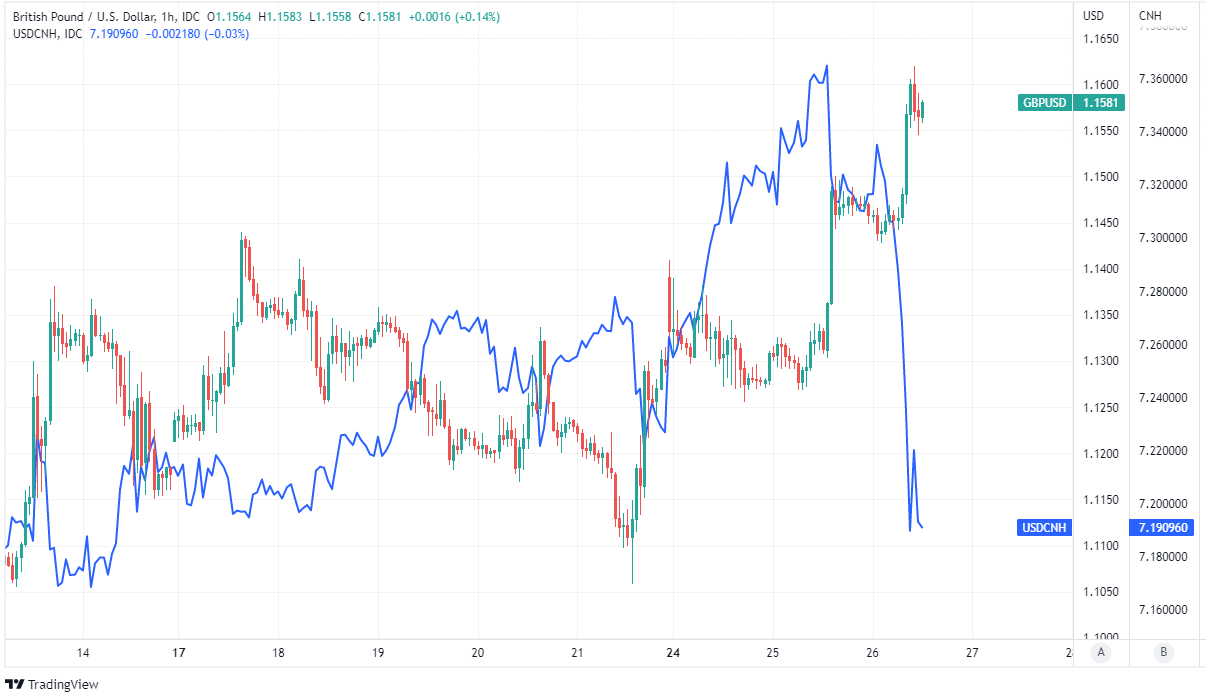GBP/USD Rate Tests 1.16 as USD Drubbed by Rallying Renminbi
- Written by: James Skinner
-

Image © Adobe Images
The Pound to Dollar exchange rate climbed further in the mid-week session to reach its highest level since the middle of September after the Chinese Renminbi surged and the U.S. Dollar fell across the board following reports of intervention from Beijing that appeared to lift all G20 currencies.
Sterling traded briefly around 1.16 against the Dollar after climbing from 1.1450 on Wednesday as it extended a two day rally that has lifted it from the 1.1058 trough reached shortly after former Chancellor Rishi Sunak was declared the winner of the Conservative Party leadership selection on Monday.
This was after Reuters reported that large state-owned banks in China had been instructed to sell Dollars in onshore and offshore markets late on Tuesday and in the middle of a Wednesday trading session that saw China's Renminbi feature as the top performing currency within the G20 grouping.
"For around one hour yesterday the value of the USD tumbled, in a move that knocked the DXY dollar index around 1% lower. The falls in the greenback have been extended this morning as US treasury yields continue to decline," says Jane Foley, head of FX strategy at Rabobank.

The Renminbi's outperformance is unusual because it tends to be a lower 'beta' or lower volatility currency than others though Sterling has a strong correlation with it and so often tends to mimick the twists and turns in USD/CNH.
Wednesday's Renminbi rally was followed by widespread declines for the Dollar that have extended a rout dating back to the afternoon hours on Tuesday.
"What’s caused this USD weakness in the last hour is quite unclear – it’s a pretty aggressive intraday move but something to be faded given the state of global growth here," says Jordan Rochester, a strategist at Nomura.
"Overall, it's been truly odd to witness USDCNH breaking higher in recent days, but risk on in equities and DXY sideways. Flows are a mess and narratives at odds with one another," Rochester wrote in a Tuesday note to clients.
The Renminbi had fallen on Tuesday to what were record lows when measured by the offshore USD/CNH exchange rate, which has risen significantly since the early April beginning of China's latest bout of coronavirus-related restrictions.
Above: Snapshot of interbank reference rates for U.S. Dollar as of 12:30 on Wednesday. Source: Netdania Markets.
Wednesday's losses for the Dollar come in the wake of potentially misplaced speculation about a forthcoming change in Federal Reserve policy after The Wall Street Journal reported last Friday that the Fed could raise its interest rate by 0.75% next week and then by a lesser 0.5% in December.
This would, however, merely be in line with September's Federal Open Market Committee forecasts, which warned that U.S. interest rates could rise to 4.5% by year-end and 4.75% early next year as part of the bank's response to inflation rates that remained at multiples of the 2% target in September.
"We are in the Fed’s blackout period so new and wishful short term narratives can be made, but if equities remain bid into the Fed meeting it's not clear to me we'll get a strong dovish impulse from the Fed next week either," Nomura's Rochester said on Tuesday.
For the Pound to Dollar rate Wednesday's rally takes it back to levels last seen on September 13 and just after former Prime Minister Liz Truss won the previous Conservative Party leadership selection process.
However, Wednesday's test of the 1.16 handle leaves the Pound-Dollar rate trading in the middle of a range that some strategists see offering an attractive opportunity to sell Sterling in anticipation of a correction lower that is expected to see it end the year somewhere between 1.08 and 1.12.

